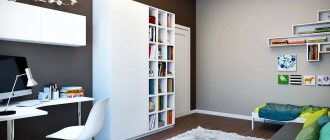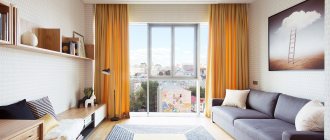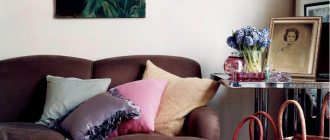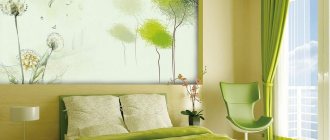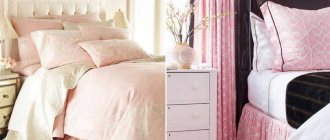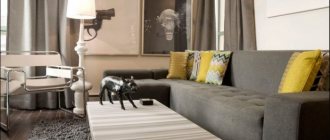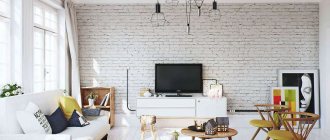Psychologists have long noticed that the color of the walls in the kitchen seriously affects a person’s emotional state and appetite. To ensure that every day family meals at home take place in a pleasant environment, it is necessary to take a responsible approach to the choice of background shades for the kitchen interior. The most original designs use combinations of several colors at once.
Plain walls - the simplest design option
Color for kitchen walls: selection rules and recommendations
Everyone has their own favorite colors for the kitchen, but not everyone is suitable for wall decoration. There are proven developments that are used in design practice:
- Bright colors will attract all the attention and will tire you if you spend a lot of time in the kitchen;
- Furniture that matches the color of the walls looks respectable, but a beautiful set will be lost against a related background;
- When deciding what wall color to choose for the kitchen, remember that cold colors reduce appetite, while warm colors provoke the desire to snack;
- Personal preferences do not always fit into interiors. Unlike clothes, you cannot use acidic shades or use 5-6 bright colors. The ideal “kitchen trio” involves a light background and two contrasting colors;
- In contrasting combinations, you cannot use “50 to 50”; a light shade should fill ¾ of the surfaces. Dark colors are suitable for contrast or graphic accents.
In principle, it is not so important what color to paint the walls in the kitchen; the main thing is to choose a good combination, correct the design flaws and place accents. According to the rules of Feng Shui, if you choose a cold color scheme, light shades are a priority. Textured surfaces (plaster, wallpaper, panels) look impressive only in combination with the smooth facades of cabinet furniture.
You can use a ready-made table of color combinations in the kitchen interior.
What wall color to choose for the kitchen, remember that cold colors reduce appetite, while warm colors provoke the desire to snack.
Shades “taken” from wallpaper
Interior designers recommend that part of the kitchen can be covered with wallpaper, and part can be painted. Colorful wallpapers can hide visually uncomfortable elements such as an air duct or a load-bearing column, but that’s not all: they can become a treasure trove of color solutions.
After all, in good wallpaper everything is very competent and professionally balanced. Just “get” the primary colors from them. You can make them lighter or darker, it’s your choice.
Author of the project: Evgenia Mishina. Photo: Sergey Krasyuk.
Author of the project: Evgenia Mishina. Photo: Sergey Krasyuk.
Basic combination techniques
When choosing the color of the walls for the kitchen, it is important to take into account all design elements, including metal fittings. A harmonious combination can set the emotional background of the room.
Important combination techniques when choosing kitchen colors:
- Pearl gray is suitable as a background for spectacular combinations with pink, blue, lilac, red and blue;
- The milky tone harmonizes with warm shades and is suitable for dark shades of the cold spectrum;
- The beige color of the walls in the kitchen is considered universal - any combination of colors and shades;
- Light brown, akin to beige, looks good with white, turquoise and azure complements;
- The pale pink color of the walls goes well with the gray, raspberry, chocolate and caramel colors of the facades;
- Burgundy and cognac look perfect with milky, pale blue and black and white contrast;
- A lavender kitchen in a Provencal style is combined with olive and pale blue walls;
- Peach and apricot combine nobly with cream in contrast with brown;
- Golden, yellow and lemon are combined with purple, black and granite;
- Turquoise and azure go well with crystal white furniture.
Black is an extravagant color, but as the main color of the walls it is not always suitable for a white “kitchen”. It is important to maintain color balance. The “cosmic” color of the walls is able to “absorb” space. Black gloss has a mirror property.
When choosing a dark color, consider the texture and light absorption of the surface. Glossy and matte textures are perceived differently.
The beige color of the walls in the kitchen is considered universal - any combination of colors and shades.
Recommendations from psychologists
Any color has an impact on a person’s psychological state. Before choosing, you should read the recommendations of psychologists.
Experts do not advise using very variegated and bright colors, as they activate the nervous system. Depending on your temperament, psychologists advise using the following colors for the kitchen :
- Cholerics should use rich red or orange.
- Phlegmatic people are prohibited from using red and orange shades.
- Sanguine people need to paint the kitchen yellow or light green.
- For melancholic people, calm shades of white, blue, indigo and brown are suitable. A similar range can be used by phlegmatic people.
Those who love bright colors should know that red has a strong effect on the psyche - it not only activates the body to action, but also increases appetite, so this solution may be required for people with anemia.
It is forbidden to use red for hypertension, unbalanced people and those prone to sudden mood changes. The solution is not suitable for those who are always trying to lose weight.
Orange has similar qualities as red, but the effect on the psyche is milder. Such walls improve your mood and improve the functioning of your digestive system. Green shades have a good effect on digestion.
Psychologists also advise taking into account the area of employment, the main type of work. Because during active everyday life it will be quite difficult to be in a bright room.
Dark shades can negatively affect a person’s mood; in addition, they are not used in small areas. If dark colors are present, they will definitely need to be diluted with softer, lighter ones.
Black and brown paints are rarely used for the kitchen, as they visually make it small and create the effect of constant dirtiness. Such a decision can worsen appetite and affect mood.
Too bright and saturated colors tire and irritate any person; warm shades give vigor, and cold shades can calm.
Choosing a light color can enliven the design; dark ones will make the kitchen restrained and calm.
Features of the geo-location of the kitchen
The degree of illumination is an important nuance when deciding how to choose the color of the walls for the kitchen.
- In low light conditions, it is advisable to choose light shades of warm colors. In the northern room, it is advisable to choose yellow, lemon or orange walls. The reflection of light will enhance furniture with a glossy facade;
- The southern location will be “cooled down” a little by blue-blue or lilac colors. A modern kitchen in purple complements well with a pink or light gray background;
- Bright shades of kitchen sets are suitable for the shaded side of the house; they are compensated by light wallpaper or plaster;
- Kitchen windows facing east receive little sunlight, so a light color scheme is recommended;
- The southwest rooms are well lit in the afternoon. Direct sunlight promotes fading. It is suggested to choose pearl gray, pale lilac or beige for the walls in the kitchen;
- Mint, lettuce or pistachio are suitable for the kitchen-dining room; they are a good alternative to bright greens.
In low light conditions, it is advisable to choose light shades of warm colors.
Fronts: glossy or matte
For a kitchen in a classic style, it is customary to choose matte facades. However, they also suit many modern styles.
Matte dark surfaces look noble and expensive; dirt is less noticeable on them. But for a cramped kitchen, this option is only permissible if the walls, floor and ceiling are light. If the room is small, be sure to read the article How to choose a kitchen set for a small kitchen.
Glossy facades suit modern minimalist styles. Because they reflect a lot of light, they are a good choice for tight or poorly lit spaces. It is easier to wash such facades, but dirt is more noticeable on them than on matte ones.
A dark, glossy finish is not the best option for countertops and backsplashes in terms of practicality: stains and dirt are very noticeable on such surfaces.
Associative properties of color
A large adjacent room will appear “cold” in blue tones. It is advisable to dilute it with more friendly companion flowers.
Walls are the basis or background for the entire interior. Before choosing the color of the “kitchen”, it is important to clarify the preferences of all family members. Small children will not say that they don’t like it, but they will be capricious and refuse to eat if the kitchen is purple or black with a red facade.
People prone to depression should not rely on the “dreary” gray-green color scheme. It is unlikely that it will be pleasant to cook and dine there in cloudy weather.
Fans of extravagant kitchen color combinations should take into account that the black ceiling “presses”, and the white and mirror floor makes one dizzy from instability.
The diagonal pattern will “brighten up” the difference in the height of the walls. Colorful wallpaper will hide small defects.
The decor of a small kitchen should be of a small format so as not to divide the space into blocks. Crushing will make it visually even smaller. Several small paintings in a row will visually lengthen the wall.
Dark shades slightly reduce the area. Light reflections reflected from glossy facades “fill” the room with cleanliness, air and light.
The decor of a small kitchen should be of a small format so as not to divide the space into blocks.
Curtains and decor
Textile design occupies a special place in design. You need to choose a style and fabric for curtains based on the style of the interior and the tasks that they must solve.
In a classic kitchen, curtains, in addition to their main function of protecting from bright light, play an important decorative role. The high cost and status of a classic interior will be emphasized by curtains or a lambrequin made of dense fabrics with a rich texture - velor, velvet, gabardine, jacquard, etc. They can be combined with light organza or tulle curtains. If the window is located next to the kitchen work area, then long curtains will have to be abandoned in favor of short curtains with tiebacks, Austrian or Roman styles.
See also 110 of the most stylish ideas for curtains for the kitchen
In a modern interior, curtains can be abandoned, especially if the window is small, the room does not have enough daylight, or if the style requires it. For example, the Scandinavian direction, hi-tech or minimalism allow for the complete absence of window curtains or almost invisible roller blinds, simple transparent or translucent light curtains without excessive decor.
Curtains can perform different functions:
- The role of a bright accent. For example, curtains of a beautiful deep shade - wine, ocher, emerald or blue - will stand out effectively against a dark gray background.
- Protection from bright light and comfort. If there is no goal to focus attention on the curtains, but curtains are still necessary (not only to protect yourself from the bright sun, but also from prying eyes in the evening, if, for example, you live on the first floor), then you can choose curtains in the main, dark colors of the interior.
- Dilute the muted color scheme. Light curtains can be the very detail that will add air and light to the interior so that it does not seem too gloomy and gloomy.
Not only curtains, but also other textile elements will help diversify and soften the interior - tablecloths and table runners, napkins for cutlery, pillows on kitchen chairs. Rough textiles made from large-weave fabric with a complex texture look especially beautiful in a dark interior.
Moderate and correct decor will emphasize the effectiveness and status of the interior. Textured and textured surfaces in the design of finishing materials and furniture, bright accents in the form of small details such as jars for spices, pillows on chairs, tablecloths, and an interesting layout of tiles on the apron will serve as decoration in themselves.
The decor can be unusual chandeliers, pendant lamps with bronze, forged, glass or crystal elements.
Wicker furniture and accessories will add coziness and warmth to the interior - napkins for cutlery made of jute or seaweed, baskets, etc.
The influence of shades on mood and well-being
Without knowing which colors are suitable for the kitchen and which are not, it is easy to make a mistake - the emotional background of the room depends on this. It is known that psychologists have noticed the relationship between color and mood.
It is not recommended to choose flashy shades, especially if you have small children. They will happily eat in a room with a yellow-green or pink-raspberry design.
The red color of the walls in the kitchen excites active children, then it is difficult to put them to bed. Blue color calms, but discourages appetite.
Children are disgusted by a black kitchen, even with mirror tiles. The situation will be corrected by decor with flowers, fruits or bright citrus slices.
The red color of the walls in the kitchen excites active children, then it is difficult to put them to bed.
How to design an apron
This zone is primarily required to be practical. Therefore, any attempts to design it must be considered through the prism of healthy pragmatics and ergonomics.
One of the key trends in recent years is segmented patchwork ceramic tiles. It enlivens the space and fits well with all modern designs.
Another current method is massive porcelain tiles measuring 60x120. Covers almost the entire area, creating a harmonious feeling of homogeneous space. The most common options are imitation marble and granite. Less commonly, slabs stylized to look like a concrete base.
The classic “hog” 10x20 and 10x30 appears less and less in interiors.
If we take a break from ceramics, then to decorate the apron you can also consider:
- threw off;
- steel panels;
- mosaic based on stone or glass;
- plastic panels with decoration.
The last option is the most affordable in terms of cost, but is only suitable when you are dealing with an electric stove.
Ideas for combining wall colors and furniture
The kitchen walls are a large format plane. Furniture determines the style and functionality of the kitchen. They must harmonize in color.
An elegant purple kitchen set has a light background:
- Gray-lilac tone;
- White;
- Pale blue;
- Fashionable color “dusty rose” (gray-pink tone).
If you have a white kitchen set, the walls can be any color. It will “get lost” against the background of white walls, so it is advisable to play up the texture of single-color surfaces. White marble countertops will look noble.
Not everyone manages to use gray tones beautifully in their design, but the color of the walls in the kitchen is in harmony with the white furniture. This is an ideal option for a high-tech kitchen. For dark facades, it is better to take the lightest tone in this range - it will be much more interesting than white walls.
If you have a white kitchen set, the walls can be any color.
Creamy and lilac
A wall painted in a different color than the kitchen front visually enriches the space. See how this can be done with companion shades of the pastel range: cream and lilac. Try to make your own “map” of pastel shades - companions.
Author of the project: Margarita Delacroix. Photo: Ivan Sorokin.
Author of the project: Margarita Delacroix. Photo: Ivan Sorokin.
What color is best for the kitchen space?
White color is considered universal. It can be offered to those who have not decided what color to paint the walls in the kitchen. It is used in all styles and design concepts.
Alternative to crystal white:
- Pearl grey;
- Pearl;
- Lactic;
- Cream;
- Light beige;
- Soft lilac;
- Blurred blue.
White color has several shades - light gray, white-blue, cream (yellowish) and pearlescent. It is not recommended to use them at the same time, otherwise against a pure white background they will look like “dirty” or “old” surfaces.
Nowadays the delicate peach color of the walls in the kitchen is widely used, but it requires gold or copper fittings. The silver-gray tone goes well with the chrome details of modern furniture - an ideal solution for urban minimalism and high-tech style.
Nowadays the delicate peach color of the walls in the kitchen is widely used, but it requires gold or copper fittings.
Stages of color selection
The first thing you need to understand is the scope of the work, so before you start designing and choosing the color of the walls, it is important to study the recommendations of designers, psychologists, and look at photographs in magazines. It is recommended to select 10 optimal options that you like and print them. After examining possible solutions, the following steps :
- The style of the kitchen is determined. Having chosen the ones you need, you will need to study all the subtleties, features and choose a shade.
- Decide on what you like, and not imitate fashion. If a certain color evokes delight and improves your mood, then you need to focus on it. This can be a base for walls or a complementary color for tables, furniture and other kitchen accessories.
- Before buying paint, take a few photographs of the kitchen, show them to the consultant, perhaps he will recommend several good options.
- It is better to choose 3 colors from the entire range. They must match the style, decorative elements, and mood. If the kitchen is planned in warm colors, you can choose a country-style kitchen, which will highlight the details.
- When purchasing, you need to use not only a photo of your kitchen, but also a small list of possible colors and additional accessories for the room. Be sure to clarify the quality of the paint, its advantages and disadvantages.
After all the stages have been completed, you can move on to decorating and painting the kitchen.
Color solutions that visually change the size of kitchens
When deciding what color to paint the kitchen in an apartment, you cannot ignore the layout features. In most projects, the cooking area is often limited in size.
When choosing options, take into account the dimensions of the kitchen, ceiling height, daytime and evening light, and existing furniture. For a small kitchen unit you need light colors, maybe in cold colors. In a kitchen where there is a large area of walls, avoid bright colors, they are tiring. Black color “steals” part of the space.
Light warm colors visually expand a small space, for example, if it is the beige color of the walls in the kitchen. A cool palette will slightly expand the narrow layout if cabinet furniture is located along the working wall.
Vertical stripes of walls and glossy stretch fabrics will “raise” the ceiling. Horizontal stripes of contrasting colors along the perimeter will make the kitchen appear wider. Diagonal lines on tiles or colored wallpaper add more dynamism to the design.
A good mood is guaranteed in a white kitchen with a silver patina in vintage style. The option in beige and apricot tones looks impressive.
Horizontal stripes of contrasting colors along the perimeter will make the kitchen appear wider.
Scandinavian design and its subtleties
Compared to the French, Scandinavian masters perceive all light neutral tones as “bright colors”; a discreet, discreet room design is important to them.
- Purple kitchen design: photo examples of real interiors
Wall color in a kitchen with brown furniture: features, how to place accents
- Chocolate color in the kitchen interior - 78 best photos of modern design
They love simplicity and conciseness. In Scandinavian cuisine, white is considered dominant. Light walls, ceiling or floor are diluted with bright colors.
The smallest additional inserts in shades of turquoise or malachite will add unusualness and freshness to the room. For small kitchens, such a design will be appropriate; it will visually expand the room, emphasizing its lightness and harmony.
Color combinations
There are ready-made principles for choosing the color of the walls in the kitchen, which are used by famous designers:
- Black and white version. Suitable for modern interior;
- Favorite color. It is not always possible to properly integrate it into a room. An extravagant fuchsia kitchen will be emotionally balanced by white walls and curtains;
- Monochrome kitchens are an excellent solution for those who do not like diversity. Beige, sky blue, gray-lilac, peach or cream shades look good. Pastel colors and some shades of green are suitable - mint, yellow-green, but you can choose the calm color of apple green;
- Classic duets. Win-win variations - blue and white, caramel-beige cuisine or white and dark chocolate. An emerald-colored kitchen is well complemented by pale blue walls, and a delicate lilac background will set off a plum-colored kitchen;
- Combinations from the color wheel. Use shades within the same color, opposite and adjacent combinations.
Those who want to slightly dilute the interior of a white kitchen are invited to decorate the kitchen floor and backsplash with tiles with a graphic pattern.
Monochrome kitchens are an excellent solution for those who do not like diversity.
Choosing a style
As we noted above, among the advantages of this color scheme is its versatility. Dark shades are appropriate in classic and modern interiors. The only difference is in the proportions: somewhere dark will dominate, and somewhere it will act more as a complementary or accent color.
Classic High-tech Minimalism
For the English style, loft and art deco, the dark color scheme of the interior is often style-forming.
Loft Kitchen in English Art Deco style
The best color combinations
Everyone loves natural combinations, where the entire design palette is based on shades that are associated with something from living nature.
The simplest combination is a two-tone kitchen. You can experiment, not forgetting that one color should be brighter, the other muted.
Extravagant trio - white, red and black. He has the right to live when they don’t know what color is best to paint the kitchen. White is by far the best background. This option can be played up if there is a soft red for the walls and a black gloss on the façade of the set.
Four shades within one color are the designers’ recommendation. For example, a lavender-colored kitchen complemented by purple, lilac and white.
The simplest combination is a two-tone kitchen.
Where did the first kitchens in bright colors appear?
France is a country where rich gourmet dishes, aromatic cheeses and fine wines are prepared. It turns out that the pioneers of colorful cuisines also appeared here.
French creators actively began to use a color palette with variegated shades of green and orange to create interiors. With such color combinations, it is better to leave the walls and floor in a neutral color so as not to weigh down the space.
It will be enough to add bright, rich accessories in the form of: furniture, kitchen utensils, facades and other attributes.
You can make the ceiling and walls white, and the floors dark; orange and green elements will add zest. Stained glass windows with depictions of berries or fruits will perfectly complement the design.
What colors should not be used in the kitchen interior?
Today there are no “forbidden” combinations, but some colors will not look decent if they are not played up.
- The dark green color of the walls is associated with the older generation with the Soviet period, when there were problems with paint, it is replaced with emerald or azure;
- Dark gray has several noble “stone” shades, but it is not recommended to use it as a basis;
- Orange is a pleasant color in all respects, but it is used in an “aggressive” trio with white and black;
- A kitchen in gold or silver looks ambitious; this is “Rublev bad manners”.
The dark green color of the walls is replaced with emerald or azure.
Small dark kitchen
There is a stereotype that dark colors are strictly contraindicated for small spaces. But it is not always the case. If there are no problems with natural light in the kitchen, and dark is used in doses and diluted with light shades, then the interior will definitely not suffer in any way, and will even benefit. In addition, dark colors can create visual effects and visually expand the space.
For example, an accent black wall creates the illusion of endless space, and a black apron looks like a portal, deceiving perception and dissolving the boundaries of the room.
Expert advice
To understand whether it will be cozy in a room with a particular shade of walls, it is worth hanging a sheet of colored paper of the chosen shade in front of your eyes or eating area. If it is perceived negatively, you should abandon the idea even before the walls are completely transformed. In percentage terms, it is important which color will be the main color in the room; the rest will be regarded as additions and accents.
Some shades of brown and terracotta look quite noble, others are “dirty”. They are not suitable for classic interiors, but they significantly enliven ethnic and country style.
For classic kitchens, pastels, wood shades, and duets with a white or beige background are suitable. You can select noble additions by duplicating them in furniture and textile designs.
Furniture is most often the basis of interior design. When choosing a successful trio or duet, they focus mainly on the color of the facade.
For classic kitchens, pastels, wood shades, and duets with a white or beige background are suitable.
Today there is no perfect palette - with every renovation you have to summarize new trends and previously purchased furniture. Some people like monochrome, when everything is one color. This solution in interior design has a drawback - it often looks boring and faceless, especially in gray. However, each tone has at least 4-5 shades. You can choose several advantageous combinations from them when deciding what color to paint your kitchen.
Walls
Bright walls will be an excellent backdrop for equally bright furniture or an elegant addition to a pastel-colored set. Sometimes just one wall is decorated with bright wallpaper or paint, distracting attention from the shortcomings of the room or the imperfections of the finishers.
Contrasting curtains or curtains that are slightly different in color will help complete the kitchen interior.
Countertop: quality or style?
There are no strict rules for choosing in this case. Most often, a neutral palette is selected: gray, beige, white, black.
The imitation stone looks interesting. This option will suit any style.
Main requirements:
- good quality material;
- high performance properties;
- compatibility with apron, facades.
Brown - goes well with almost the entire palette
Curtains for windows
Window decoration is essential in any interior. Thick, good-quality curtains will be inappropriate.
It is best to choose light, thin fabrics that match the rest of the interior. They do not burden the perception of space.
Gray color is universal
Curtains can be plain or contain prints that match the style of the room. Bright colors are rarely chosen; usually preference is given to a calm color scheme, white.
What tones are warm
The world around us consists of many shades. Everywhere you can see a huge number of color compositions and combinations. But this is only a small part of what is visible to birds and insects! Previously, artists used a system of decomposing white into seven tones. Today, designers use a more advanced structure - a diagram of warm and cold shades. This system of color separation allows you to more accurately convey warm or cold moods in art, including in interior design.
Human vision is capable of perceiving only 7 shades. Moreover, as experiments with color prove, all these tones can be obtained from three basic colors - yellow, red and blue, as well as an additional white color. With three basic shades you can achieve absolutely any color. If you need to make the composition warm or cold, you just need to add more yellow, red or blue.
To decorate the interior (including the kitchen), it is possible to use three color groups:
- Warm colors: yellow, red, orange.
- Cool shades: blue, cyan, purple.
- Green tones that can be either warm or cool. Designers tend to consider green a balanced, neutral color.
This division of colors into groups is quite arbitrary. It is much more important to choose the right color composition, in which the tones will be in harmony with each other. When choosing shades, you need to rely on our perception of specific combinations.
We perceive all colors only through the organ of vision. However, if we talk about warm and cold shades, the instinctive, receptor perception of cold and heat is connected here. This is why we can divide colors into two corresponding groups.
Recommended articles on this topic:
- Cupboard for kitchen utensils: decorating your interior
- Italian style chest of drawers: 6 types for your interior
- Solid wood kitchen (30+ photos): noble luxury and home comfort
Sunny and warm yellow - fashionable interior colors of 2022
Yellow is the color that reigned supreme at the 2021 Interior Design Show. It appeared not only - as has been customary for several seasons - in accessories, but also on the walls of rooms, kitchen fronts and even the upholstery of living room furniture. The choice of Tikkurilla, one of the largest paint manufacturers in the world, was Lemonade H300.
It is an optimistic, warm and gentle, muted shade of yellow with visible brown additions. As brand experts explain, this color is associated with the first rays of the sun in the morning, immediately after dawn. Thanks to this, it can add comfort and a positive attitude to life.
The institute that believes yellow in particular will be owned by 2022 is also WGSN, a color trend forecasting company. Its specialists pointed to a strong, warm, earthy shade of Mellow Yellow as one of the key colors, which can be called a shade of retro mustard yellow or bleached ocher.
Calming and relaxing green - color trends for 2021
Several different shades of green have emerged among the 2022 flowers. The trending shade for the kitchen is Back to Nature S 340-4, which is an olive-light green with warm tones obtained by adding bronze. This color, which we associate, among other things, with meadows and nature, promotes contemplation and tranquility.
A dark, strong shade of bottle green, Adeline, has been announced by British company Graham & Brown. This color, according to the brand’s specialists, is a way to update the trend of the currently fashionable emerald green, and it is also associated with the mature greenery of tree leaves.
The greenery-inspired color palette also includes a tranquil sunrise shade known as mint grey. This subtle shade of warm gray mixed with colors such as green and blue is meant to evoke the morning sky and, like the dawn, be a symbol of new discovery.
Among the colors for the kitchen, there was also Dunn-Edwards' Minty Fresh DE5687, which is a cool, pastel green with clear menthol tones. WGSN also chose to forecast color trends, listing the minty, light shade of Neo Mint as one of the top five colors for 2022.
A kitchen painted green will not only be more cozy, but also relaxing. Nothing is more relaxing than being in touch with nature. This color can be introduced into interiors both in the form of the colors of 2022, i.e. Adeline, Back to Nature, Tranquil Dawn or Minty Fresh and Neo Mint, as well as other fashionable shades, such as sage or green peas.
Manufacturers offer us not only kitchen interior paints in these colors - which can be used to paint all or only selected interior walls. These colors are also available in the offer of floor and wall tiles, wallpapers, kitchen furniture, leisure sets, lighting or accessories, ceramics.
How to introduce shades of yellow?
Carefully use additions in the versions suggested by the manufacturers Lemonade or Mellow Yellow, as well as ocher and yellow mustard. Velvet carpets and even ceramic decorations are perfect for this role. In bolder kitchen interiors, yellow can be used on the walls.
There are three options to choose from: trendy custom geometric yellow decorations such as stripes or circles placed on one wall, one wall painted a rich color, or the entire kitchen covered in yellow paint or wallpaper.


